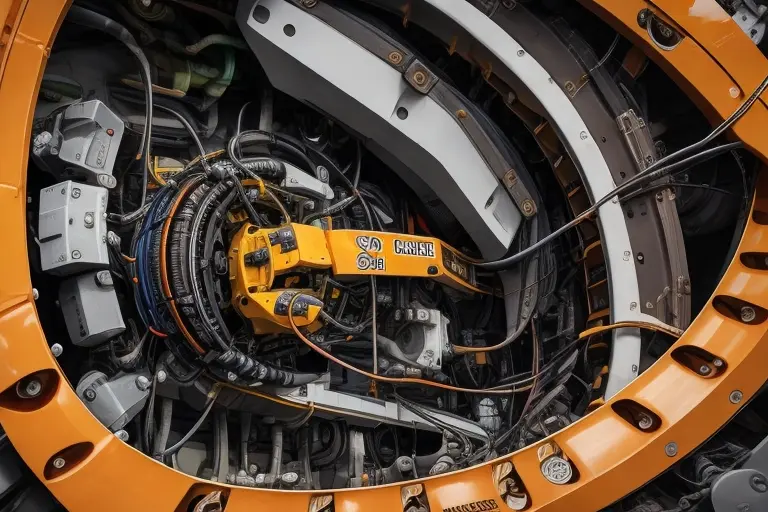Introduction
Welcome to our in-depth guide on the Caterpillar S40 electrical system. Whether you’re a heavy machinery enthusiast, a Caterpillar equipment owner, or just someone curious about how these impressive machines work, you’re in the right place. In this guide, we’ll take you through the ins and outs of the Caterpillar S40’s electrical setup, from its components to troubleshooting and maintenance tips.
Section 1: The Heart of the System – Battery and Alternator
The Caterpillar S40’s electrical system starts with the battery and alternator, just like in your car. The battery stores electrical energy, while the alternator keeps it charged. These components are vital for starting the engine and powering various electrical systems on the machine.
It’s crucial to regularly inspect your battery for corrosion, loose connections, and proper voltage levels. A healthy battery ensures reliable starts and prevents unexpected downtime. If you notice any issues, consider replacing it or seeking professional assistance.
Section 2: Wiring and Circuits
Wiring and circuits are the nerves and pathways of the Caterpillar S40’s electrical system. They connect all the electrical components, allowing them to communicate and function seamlessly. Damaged or corroded wires can lead to electrical malfunctions, so regular inspections are essential.
If you encounter electrical problems, trace the wiring to identify any frayed or damaged sections. Properly maintained wiring ensures that power flows smoothly to various parts of the machine, enhancing its overall performance.
Section 3: Fuses and Circuit Breakers
Fuses and circuit breakers act as the system’s safety net, preventing electrical overloads and fires. If too much current flows through a circuit, these devices automatically interrupt the power supply, protecting the system and your safety.
Check your Caterpillar S40’s fuses and circuit breakers regularly. If you find any blown fuses, replace them with ones of the same rating. Understanding these safety features can save you from potential electrical hazards.
Section 4: Lights and Signals
The Caterpillar S40 relies on a variety of lights and signals for safe operation. From headlights and taillights to turn signals and warning lights, these components play a crucial role in ensuring visibility and communication on the job site.
Inspect your lights regularly to ensure they are clean, functional, and properly aligned. Properly functioning lights enhance safety during night work and in low-light conditions.
Section 5: Sensors and Gauges
Modern heavy machinery like the Caterpillar S40 is equipped with an array of sensors and gauges that provide real-time data on engine performance and system health. These include temperature sensors, pressure gauges, and more.
Understanding how to interpret the readings from these sensors can help you identify potential issues early and prevent costly breakdowns. Regularly check the accuracy of these gauges and sensors to maintain optimal machine performance.
Section 6: Troubleshooting Common Electrical Problems
Electrical issues can disrupt your work and lead to costly downtime. In this section, we’ll discuss some common electrical problems in Caterpillar S40 machines and how to troubleshoot them. From starter motor problems to electrical shorts, we’ve got you covered with practical solutions.
Section 7: Regular Maintenance Practices
Preventive maintenance is key to ensuring the longevity of your Caterpillar S40’s electrical system. We’ll provide you with a checklist of routine maintenance tasks to keep your machine running smoothly. Proper care can extend the life of your equipment and save you money in the long run.
Section 8: Professional Assistance and Repairs
While regular maintenance can address many issues, there may come a time when you need professional help. We’ll guide you on when it’s best to consult a Caterpillar service technician and what to expect during the repair process. Timely professional assistance can prevent minor issues from turning into major problems.
Section 9: Conclusion
In conclusion, understanding the Caterpillar S40 electrical system is essential for any owner or operator. Regular maintenance, troubleshooting skills, and knowing when to seek professional help are the keys to ensuring your machine’s reliability and longevity. By following the tips and guidelines provided in this guide, you can confidently tackle electrical issues and keep your Caterpillar S40 running at its best.
We hope you found this guide informative and helpful in your journey to master the Caterpillar S40 electrical system. If you have any questions or would like to share your experiences, feel free to leave a comment below. Happy operating!
Explore the rest of our website Tech Glints, intriguing articles await you! Interested in contributing? Simply click the contact button at the top right. Thank you!
